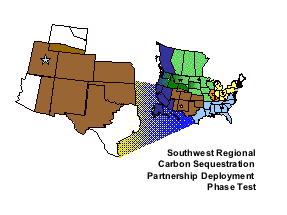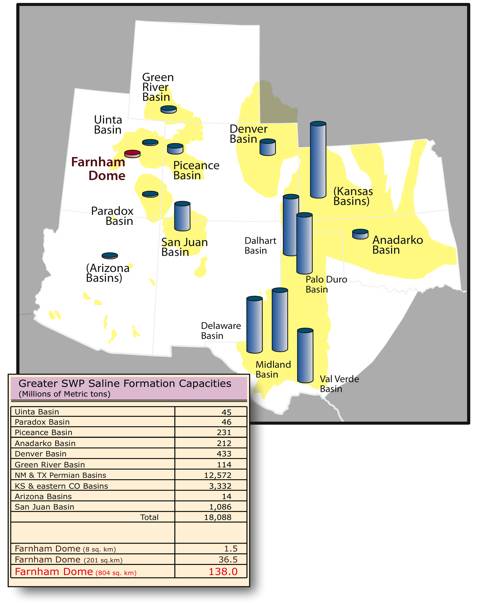Farnham Dome/Uinta Basin
Southwest
Regional Partnership on Carbon Sequestration — Deployment Phase
Background
As part of a comprehensive effort to assess options
for sustainable energy systems, the U.S. Department of Energy has selected
seven Regional Partnerships, through its Regional Carbon Sequestration
Partnership (RCSP) Program, to determine the best approaches for capturing and
permanently storing carbon dioxide (CO2), a greenhouse gas which can
contribute to global climate change. The RCSPs are made up of state agencies, universities,
private companies, national laboratories, and nonprofit organizations that form
the core of a nationwide network helping to establish the most suitable
technologies, regulations, and infrastructure needs for carbon sequestration.
Altogether, the Partnerships include more than 350 organizations, spanning 41
states, two Indian nations, and four Canadian provinces.
The Regional Partnership initiative is being
implemented in three phases. The Characterization Phase began in September 2003
with the seven Partnerships working to develop the necessary framework to
validate and potentially deploy carbon sequestration technologies. In June
2005, work transitioned to the Validation Phase, a four-year effort focused on
validating promising CO2 sequestration opportunities through a
series of field tests in the seven regions. Presently, activities in the
Deployment Phase (2008-2017) are proceeding as an extension of the work
completed to date and will demonstrate that CO2 capture,
transportation, injection, and storage can be achieved safely, permanently, and
economically at a large scale. These tests will promote understanding of
injectivity, capacity, and storability of CO2 in the various
geologic formations identified by the Partnerships. Results and assessments
from these efforts will assist commercialization efforts for future
sequestration projects in North America.
The Southwest Regional Partnership on Carbon Sequestration (SWP)
includes the
states of Arizona, Colorado, Kansas, New Mexico, Oklahoma, Texas, Utah, and
Wyoming. The SWP includes over 50 organizations. The eight states in the
Southwest Regional Partnership account for about 10 percent of U.S. CO2
emissions from stationary sources. The region offers significant potential for
sequestration in saline formations, unmineable coal seams, and depleting oil
and gas reservoirs. Of particular interest is the use of CO2 for
enhanced oil recovery (EOR) in tandem with sequestration.
Project Description
Project Summary
SWP will accomplish a major sequestration deployment in
the Farnham Dome in central Utah. This test will follow an injection schedule
over 4 years, leading up to 900,000 tonnes (1 million U.S. tons) of CO2
per year. The target formations for this deployment include deep Jurassic-,
Triassic-, and Permian-aged sandstones in the Farnham Dome of Utah. These
formations are also targets of potential commercial sequestration throughout
the western United States. The SWP plans include a “dual completion” with
injection in two different formations at the same time. By carrying out two tests in two
different formations within the same stratigraphy, portability of science and
engineering results can begin to be evaluated.

Injection Site Description
The Farnham Dome injection
site is located just southwest of the Uinta basin near Price, Utah, 120 miles
south of Salt Lake City, in central Utah.
Farnham Dome is an elongated surface anticline located along the
northern plunge of the San Rafael uplift.
Drilling
along the crest of Farnham Dome in the 1920s and 1930s resulted in the
discovery of significant deposits of CO2 in the Jurassic Navajo
Sandstone and small shows of CO2 in Triassic, Permian, and Pennsylvanian
reservoirs. Given that the more
shallow Jurassic units hold significant CO2, the deeper Triassic and
Permian units appear promising with respect to large CO2 capacities
and low risk with respect to leakage.
The area provides an excellent deployment test opportunity for analysis
of high injection rates and high resolution monitoring of CO2 in
multiple rock layer horizons.
These deep saline formations are major targets for commercial-scale
sequestration associated with future coal-fired power plants planned for the
area. Much of the Farnham Dome
site falls under jurisdiction of the U.S. Bureau of Land Management.
Description
of Geology
The
target formations are deep saline units present throughout the Southwest
Partnership region, as well as in many states outside the region. In all cases,
the seal is the Morrison Formation, a thick (400 feet) shale/gypsum/siltstone
of Jurassic age, also regionally present throughout the SWP states. At the
Farnham Dome and all other sites, the target units lie within a true “stacked”
system—above the Morrison formation lies the Dakota formation, a
Cretaceous-aged sandstone similar to the deep Triassic and Permian sands, and
capped by the Pierre/Mancos shale, a very thick (1,500 feet to 5,000 feet) shale
unit. The SWP has gathered porosity, permeability, mechanical, compositional,
and geophysical data associated with these target formations and seals.
Source
of CO2
For the Farnham Dome deployment site,
the sources of CO2 include natural CO2 from the Jurassic-aged
Nugget Sandstone. A second
potential source is a coalbed methane (CBM) production field northwest of
Price, Utah; the CBM operation currently vents over 100,000 tons of CO2
per year. A short pipeline will need to be added to facilitate injection of captured
CO2 into the deep saline reservoirs at Farnham Dome. All CO2
captured will be 97 percent pure, with the remainder nitrogen (air).
For
the Farnham Dome site in Utah, a minimal length of pipeline will be added in
order to deliver the CO2 for deep injection. Blue Source LLC, a SWP
partner, and Savoy Energy LLC, the field operator, are completing designs for
necessary pipelines. Upon completion of the deployment phase test, this
pipeline will be used to transport the captured CO2 from the Farnham
Dome site to the Uinta Basin enhanced oil recovery market.
Simulation and Monitoring of CO2
The
project will require extensive monitoring and simulation to determine if the
storage operations are effective in trapping the injected CO2 for
millennia. Vertical seismic
profiling and microgravity methods will be particularly utilized, given their
proven ability to resolve the size of the CO2 plume. Monitoring, mitigation, and
verification (MMV) techniques that will be used include repeat 3-D seismic
surveys, pressure monitoring, groundwater chemistry monitoring, pressure and
fluid sample monitoring from other locations, soil gas sampling, and other
methods. A variety of “in house”
and commercial/public simulation tools will be used, including GEM, TOUGH2,
TOUGHREACT, FEHM, CO2-PENS, COMSOL, THRUST3D, MRKEOS and SWEOS.
Goals and Objectives
SWP’s overall goal is to
validate the information and technology developed under the Characterization
and Validation Phases relative to research and field activities, public
outreach efforts, and regional characterization. Specific objectives include:
·
Develop an overall
methodology that optimizes engineering and planning for future commercial-scale
sequestration projects
·
Conduct successful
large-scale CO2 injection projects targeted at Jurassic and older
sandstone formations
·
Achieve a more thorough
understanding of the science, technology, regulatory framework, risk factors,
and public opinion issues associated with large-scale injection operations
·
Validate MMV activities,
modeling, and equipment operations.
·
Refine capacity
estimates of the target formation using results of the tests
 Figure
1. Southwest Region CO2 sequestration capacities for deep saline
formations that are Jurassic and older in age. Different capacities indicated for Farnham Dome correspond
to different radii (extent of subsurface structure) under consideration for
sequestration.
Figure
1. Southwest Region CO2 sequestration capacities for deep saline
formations that are Jurassic and older in age. Different capacities indicated for Farnham Dome correspond
to different radii (extent of subsurface structure) under consideration for
sequestration.
Benefits
to the Region
The
SWP’s Characterization and Validation Phase analyses determined that the
region’s point sources emit approximately 320 million tonnes (350 million U.S.
tons) of CO2 per year, which for 100 years (assuming no change in
emissions rate) translates to 32 billion tonnes (35 billion U.S. tons) total
storage capacity needed. The SWP’s Characterization and Validation Phase
analyses provide an initial estimate of capacity of the deep Jurassic and older
saline reservoirs in the Southwest region to exceed 18 billion tonnes (20
billion U.S. tons), over the 50% criterion (Figure 1). The Farnham Dome Phase III deployment
site, in comparison, is projected to store at least 138 million metric tons of
CO2 in formations that are Jurassic and older. During the Deployment
Phase, SWP will continue to refine capacity estimates and evaluate injectivity
and other critical factors relevant to regional storage goals.

